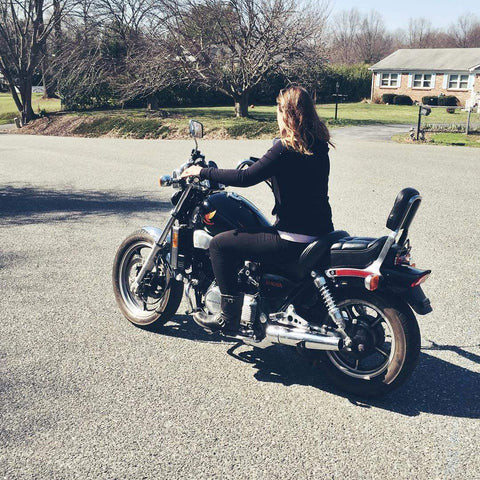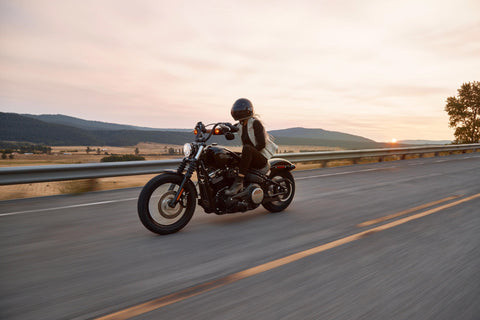Starting your motorcycle journey is an exhilarating experience. However, with a vast array of options available, selecting the right first bike can feel overwhelming. Forget the myth of a single “best beginner bike.” The ideal motorcycle for you is a personal choice, dependent on your individual needs and aspirations. This guide will cut through the noise and empower you to find the perfect “good beginner street bike” to kickstart your riding adventure.
It’s All About You: The Rider’s Profile
Before diving into motorcycle specifications, take a moment to reflect on yourself. Understanding your motivations, physical attributes, and preferences is crucial in narrowing down your choices. Ask yourself these key questions:
- Why am I drawn to riding? Is it for commuting, weekend fun, long-distance touring, or perhaps exploring off-road trails later on?
- What do I hope to achieve with motorcycling? Skill development, social riding, personal freedom, or a specific type of adventure?
- Which motorcycle styles visually appeal to me? Do you prefer the sporty look, the classic aesthetic, or the rugged adventure style?
- Am I a quick study or do I learn at a more deliberate pace? Your learning style can influence the initial power and handling you’re comfortable with.
- What is my height and weight? These factors impact bike ergonomics, seat height, and overall maneuverability.
- What is my budget for purchasing a motorcycle and gear? Factor in not just the bike cost, but also essential riding gear, insurance, and maintenance.
By answering these questions honestly, you’ll begin to form a rider profile that will guide your search for the perfect beginner street bike.
Key Features of Good Beginner Street Bikes
While there’s no magic formula, certain characteristics make a motorcycle more beginner-friendly. These features are generally associated with easier handling, forgiveness for mistakes, and a confidence-inspiring riding experience.
 Team EARPEACE member, Lemon, proudly showcasing her vintage 1985 Honda Magna as her first street motorcycle.
Team EARPEACE member, Lemon, proudly showcasing her vintage 1985 Honda Magna as her first street motorcycle.
Team EARPEACE member, Lemon, on her first road bike–a 1985 Honda Magna
Manageable Engine Displacement
Engine displacement, measured in cubic centimeters (cc), indicates the engine’s size and power output. While larger engines generally mean more power, for beginners, a smaller, more manageable engine is often preferable. It’s not just about displacement numbers; the engine configuration also plays a significant role in how the power is delivered. For instance, a 600cc inline-four sportbike can feel much more aggressive than a 650cc parallel-twin, despite the similar displacement. For a deeper understanding, resources like Cycle World’s engine explanation are invaluable.
Beginner-friendly engines prioritize smooth, predictable power delivery. This forgiving nature is essential as you learn to control the throttle, clutch, and brakes. Mistakes are inevitable during the learning process, and a less powerful bike is more forgiving, allowing you to recover and learn from them safely.
Some riders might suggest starting with a mid-sized bike to avoid “outgrowing” a smaller one too quickly. While it’s true you’ll likely progress beyond your first bike, remember that it’s a stepping stone. Outgrowing it is a natural part of skill development. Mid-sized bikes (500cc-650cc) can offer more highway capability and sometimes better components, but starting smaller (250cc-400cc) can build confidence and fundamental skills more effectively, especially if you feel apprehensive or prefer a gradual learning curve. Don’t be fooled by engine size alone; the overall bike design and engine characteristics are equally important.
Engine configurations commonly found in street bikes include:
- Single-cylinder: Simple, lightweight, and fuel-efficient, often found in smaller displacement beginner bikes. Power delivery is typically very linear and predictable.
- Parallel-twin: A popular choice for beginners, offering a good balance of power and manageability. Power delivery is generally smooth and linear, making them easy to control.
- V-twin: Characterized by a distinctive sound and torque-rich power delivery. Can be slightly less linear than parallel twins but still manageable for many beginners, especially in larger displacement cruisers.
- Inline-four: Known for their smooth, high-revving power, more common in sportbikes and larger displacement machines, generally less beginner-friendly due to potentially abrupt power delivery.
For beginner street bikes, parallel-twin and single-cylinder engines are widely considered the most approachable. They offer predictable power bands, meaning the power builds smoothly and progressively as you increase the throttle, without sudden surges that can be intimidating for new riders.
Excellent examples of beginner-friendly bikes with these engine types include the Kawasaki Ninja 400 (parallel-twin), Yamaha R3 (parallel-twin), Honda CB300R (single-cylinder), Honda Rebel 300 (single-cylinder), BMW G310R (single-cylinder), KTM Duke 390 (single-cylinder), Suzuki SV650 (V-twin), and Royal Enfield Himalayan (single-cylinder). As Ultimate Motorcycling points out, these engine types are well-suited for new riders.
 Moto Pro Earplugs for Motorcyclists
Moto Pro Earplugs for Motorcyclists
Seat Height and Overall Weight
A motorcycle’s seat height and weight are crucial considerations for new riders, often more so for those who are shorter in stature. While the ability to “flat-foot,” meaning placing both feet flat on the ground while seated, is often perceived as essential, it’s not strictly necessary. As you gain experience, you’ll become comfortable balancing the bike and can learn techniques to manage even if you can only reach the ground with your toes or one foot firmly planted, as explained by the Motorcycle Legal Foundation.
Instead of solely focusing on seat height specifications, consider the bike’s overall ergonomics. The width of the seat and fuel tank significantly impacts how tall a bike feels. Narrower bikes are easier to straddle, which is a key reason why single and parallel-twin cylinder bikes are popular beginner choices – their engine design often leads to a slimmer profile.
Furthermore, the bike’s center of gravity plays a vital role in how manageable its weight feels. Cruiser motorcycles, frequently favored by shorter riders, typically have low seat heights and a low center of gravity, contributing to a planted and stable feel. Sportbikes and adventure bikes, on the other hand, often have a higher center of gravity and can feel top-heavy, especially at low speeds. Standard or “naked” bikes often strike a good balance, offering a comfortable riding position and manageable weight distribution.
The best way to assess a bike’s height and weight is to physically sit on it. Visit a motorcycle dealership, sit on various models, and gently lean them from side to side. This hands-on experience will provide a much clearer understanding of which bikes feel comfortable and manageable for you.
Motorcycle Types and Riding Styles
Motorcycles are designed for diverse purposes, and each category excels in certain areas while being less suited for others. Think about your riding aspirations:
- Sportbikes: If you admire MotoGP racers and crave speed and agility, sportbikes like the Yamaha R3 or Ninja 400 might appeal to you. They are designed for performance on paved roads and track days.
- Adventure Bikes: Dreaming of long-distance journeys and exploring unpaved roads? Adventure bikes like the Royal Enfield Himalayan are built for rugged terrain and long-distance comfort.
- Cruisers: If you’re drawn to classic styling, relaxed riding posture, and perhaps the “chopper” aesthetic, cruisers like the Honda Rebel or Harley-Davidson Sportster offer a comfortable and stylish entry point.
- Naked Bikes (Standards): These versatile machines, like the Suzuki SV650 or Yamaha MT-07, are excellent all-rounders. They are comfortable for commuting, fun on twisty roads, and even capable of light touring.
- Retro/Classic Bikes: For riders who appreciate vintage aesthetics, bikes like the Triumph Bonneville offer timeless style and modern reliability.
It’s perfectly fine if you’re unsure about your preferred riding style initially. Learning to ride is an exploration. Your motorcycle can become an extension of your personality and a powerful form of self-expression.
 A stylish Harley-Davidson motorcycle parked outdoors, embodying freedom and the open road.
A stylish Harley-Davidson motorcycle parked outdoors, embodying freedom and the open road.
Photo by Harley-Davidson on Unsplash
Budget Considerations for Your First Bike
Let’s be realistic: most riders, even experienced ones, have dropped a bike at some point, especially when learning. It’s almost a rite of passage! Starting with a used motorcycle can significantly reduce the financial sting of any accidental drops or scrapes that might occur during your learning curve. Used bikes have already undergone their initial depreciation, meaning you can often buy, learn on, and resell them later without losing a significant amount of money. Even if you can afford a new bike, a used one can be a financially prudent choice for your first motorcycle. The used market offers a wide selection of well-maintained, affordable motorcycles perfect for beginners.
Crucially, don’t forget to budget for essential riding gear. Plan to invest around $1,500 for a full set of protective gear, including a helmet, jacket, gloves, pants, and boots. High-quality gear is not an optional expense; it’s a vital safety investment. Consider the cost of medical treatment for injuries like road rash – skin graft surgery can easily cost tens of thousands of dollars. Investing in durable protective gear, like Kevlar jeans, can be a fraction of that cost and provide invaluable protection. For more safety advice, explore resources like Three Things You Should Never Ride Without.
Pro Tip: If you’re financing your motorcycle, many lenders allow you to include the cost of gear and accessories in the loan, spreading out the expense.
Another budget factor is motorcycle insurance. Larger displacement bikes and sportbikes typically have higher insurance premiums. Obtain insurance quotes for different models before making a purchase to get a complete picture of the ongoing ownership costs.
ABS Brakes: A Beginner Safety Net?
Anti-lock Braking Systems (ABS) are a proven safety technology designed to prevent wheel lock-up during hard braking. In emergency situations, riders may instinctively brake too forcefully, causing the wheels to skid and lose traction, potentially leading to a loss of control. ABS modulates braking pressure, preventing wheel lock-up and helping maintain stability.
Some experienced riders argue that relying on ABS can hinder the development of essential braking skills. Mastering proper braking technique without electronic aids is undoubtedly a crucial skill for any motorcyclist.
However, for beginners, ABS can provide an extra layer of safety and confidence. It can be particularly helpful in unexpected situations or on slippery surfaces. While developing strong braking skills is paramount, ABS can act as a safety net, especially during the initial learning phase. If ABS enhances your confidence and peace of mind, choosing a bike equipped with it is a worthwhile consideration. If your chosen bike doesn’t have ABS, focus on practicing proper braking techniques in a safe, controlled environment to build your skills and muscle memory. Skill and technique are ultimately the most valuable safety assets on any motorcycle.
Ready to Ride: Your Adventure Begins
With this comprehensive guide, you’re now equipped to navigate the world of beginner street bikes and choose the perfect machine to start your motorcycle journey. Remember, while these guidelines provide a solid foundation, the ultimate decision is yours. Don’t be afraid to deviate from conventional advice and choose the bike that truly excites you. As long as you approach riding with determination and a commitment to learning, you can master almost any motorcycle. Explore resources like Six of the Best Motorcycle Rides in the United States to plan your future adventures. Ultimately, the best beginner street bike is the one that inspires you to ride, learn, and enjoy the incredible world of motorcycling. And remember to protect your hearing with motorcycle earplugs against wind noise for a more comfortable and safer ride. Ride safe and have fun!
